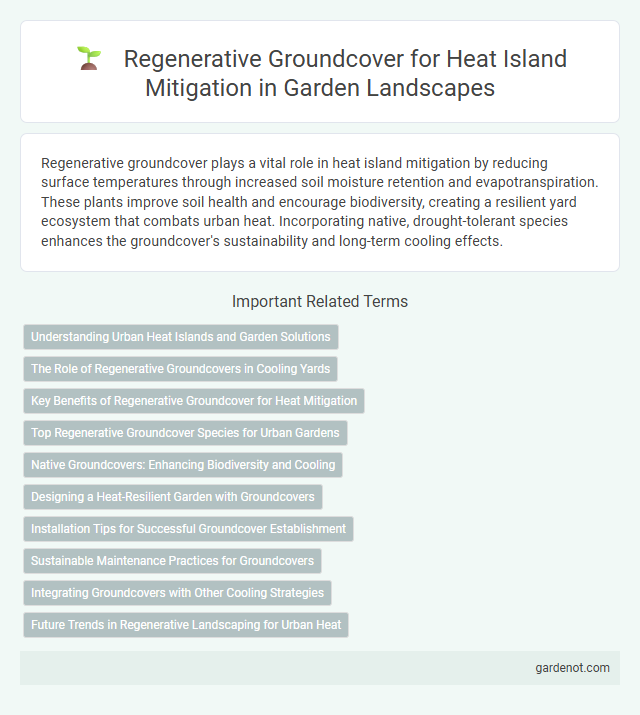Regenerative groundcover plays a vital role in heat island mitigation by reducing surface temperatures through increased soil moisture retention and evapotranspiration. These plants improve soil health and encourage biodiversity, creating a resilient yard ecosystem that combats urban heat. Incorporating native, drought-tolerant species enhances the groundcover's sustainability and long-term cooling effects.
Understanding Urban Heat Islands and Garden Solutions
Urban heat islands result from dense infrastructure absorbing and retaining heat, elevating local temperatures significantly. Regenerative groundcover, such as native grasses and low-growing plants, restores soil health and improves moisture retention, reducing surface heat and cooling the surrounding air. Implementing these garden solutions effectively mitigates heat island effects by enhancing evapotranspiration and shading impervious surfaces in urban yards.
The Role of Regenerative Groundcovers in Cooling Yards
Regenerative groundcovers play a crucial role in mitigating urban heat islands by enhancing soil moisture retention and increasing surface albedo, which collectively reduce ambient temperatures in yards. These plants promote healthy soil microbiomes and carbon sequestration, improving long-term ecosystem resilience against thermal stress. Their dense foliage and rooting systems also minimize heat absorption by hard surfaces, contributing significantly to natural cooling effects in residential and commercial outdoor spaces.
Key Benefits of Regenerative Groundcover for Heat Mitigation
Regenerative groundcover significantly reduces surface temperatures by enhancing soil moisture retention and increasing vegetation density, which in turn lowers the urban heat island effect. These plants improve soil health through natural processes like nitrogen fixation and carbon sequestration, promoting long-term sustainability in urban environments. Their ability to provide shade and reduce heat reflection contributes to cooler microclimates around residential and commercial yards.
Top Regenerative Groundcover Species for Urban Gardens
Top regenerative groundcover species for urban gardens include clover, creeping thyme, and sedum, known for their ability to improve soil health and retain moisture. These plants reduce heat island effects by providing shade and enhancing soil organic matter, crucial for urban heat mitigation. Utilizing drought-tolerant and nitrogen-fixing groundcovers promotes sustainable urban green spaces that combat temperature spikes.
Native Groundcovers: Enhancing Biodiversity and Cooling
Native groundcovers play a crucial role in heat island mitigation yards by enhancing biodiversity and providing natural cooling through evapotranspiration. These plants improve soil health, support local pollinators, and reduce surface temperatures, effectively lowering heat retention in urban areas. Incorporating diverse native species maximizes ecological benefits and creates resilient, sustainable outdoor environments.
Designing a Heat-Resilient Garden with Groundcovers
Regenerative groundcovers play a critical role in designing a heat-resilient garden by reducing surface temperatures and improving soil moisture retention, which mitigates urban heat island effects. Selecting drought-tolerant species like creeping thyme, sedum, or native clover enhances resilience while promoting biodiversity and soil health. Integrating layered plantings with groundcovers creates a microclimate that lowers ambient temperatures and reduces heat absorption in yard environments.
Installation Tips for Successful Groundcover Establishment
Select drought-tolerant, native plants like creeping thyme or sedum for regenerative groundcover to enhance heat island mitigation in yards. Prepare soil by loosening the top layer and incorporating organic compost to improve drainage and nutrient retention. Water consistently during the initial establishment phase, avoiding over-saturation, to ensure deep root growth and long-term groundcover success.
Sustainable Maintenance Practices for Groundcovers
Regenerative groundcovers enhance heat island mitigation by promoting soil health and reducing irrigation needs through sustainable maintenance practices such as organic mulching and minimal chemical use. These groundcovers improve urban microclimates by increasing soil moisture retention and supporting beneficial microbial activity. Sustainable management reduces environmental impact and supports long-term resilience in urban landscaping solutions.
Integrating Groundcovers with Other Cooling Strategies
Integrating regenerative groundcovers with other cooling strategies, such as permeable pavements and shade trees, enhances heat island mitigation by promoting natural evapotranspiration and reducing surface temperatures. These groundcovers improve soil health and moisture retention, amplifying the cooling effects of adjacent green infrastructure. Combining multiple green elements creates synergistic benefits that optimize urban microclimates and reduce reliance on energy-intensive cooling systems.
Future Trends in Regenerative Landscaping for Urban Heat
Future trends in regenerative landscaping emphasize heat island mitigation through innovative groundcover solutions that enhance soil health and increase urban albedo. Native and drought-resistant plants with deep root systems are prioritized to improve ground moisture retention and reduce surface temperatures. Integrating biochar-infused substrates and mycorrhizal networks further boosts ecosystem resilience and urban thermal comfort.
Regenerative groundcover Infographic

 gardenot.com
gardenot.com